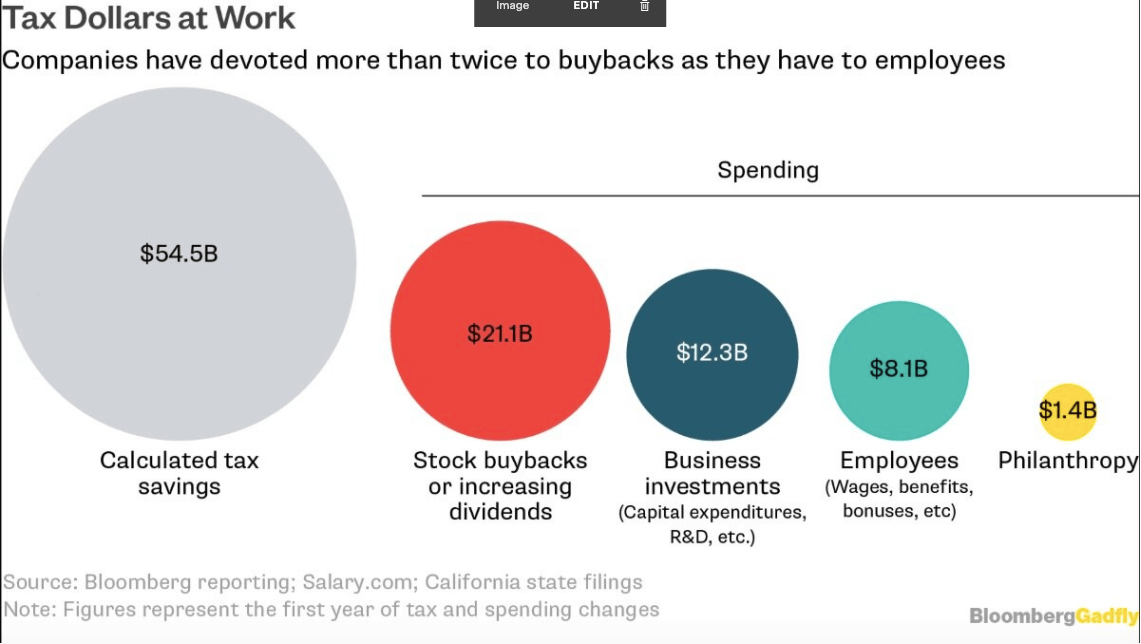As part of The CARES Act, Congress imposed restrictions on stock buybacks. There was bipartisan support for this idea. Billionaire Mark Cuban argued that the rule for any company that receives federal assistance is, “No buybacks. Not now. Not a year from now. Not 20 years from now. Not ever.” Senate Minority Leader Chuck Schumer declared on-air: “Our motto in this is ‘workers first.’ …. These buybacks, they infuriate me. We should not be allowing them to do buybacks, raise corporate salaries.” Sen. Elizabeth Warren said that any corporate recipient of government assistance should be “permanently prohibited from engaging in share repurchases.” President Trump joined the chorus arguing, “I am strongly recommending a buyback exclusion. You can’t take a billion dollars of the money and just buy back your stock and increase the value.” However, others have argued that this policy is “The Worst Coronavirus Idea.”
How it Happened
The airline industry was the poster child for arguments against buybacks. Airlines for America, which represents major U.S. passenger and cargo air carrier companies, requested government assistance because of (i) the coronavirus crisis, and (ii) several of the largest carriers had used the majority of their free cash flow on share buybacks over the last decade. Given that airlines have a propensity for going bankrupt with over 60 since 1991, and being unprepared for hard times including the Sept. 11, 2001, attacks and the volcanic eruption in Iceland in 2010 that disrupted air travel, building up cash for a rainy day hasn’t been part of their plan.
| Airline | Free Cash Flow ($MM) | Share Buybacks ($MM) | Buybacks/FCF |
|---|---|---|---|
| Southwest Airlines Co. | 15,103 | 10,650 | 71% |
| Alaska Air Group, Inc. | 4,948 | 1,590 | 32 |
| Delta Air Lines, Inc. | 23,186 | 11,430 | 49% |
| United Airlines Holdings, Inc. | 11,526 | 8,883 | 77% |
| American Airlines Group, Inc. | (7,935) | 12,957 | N/A |
| JetBlue Airways Corporation | 2,347 | 1,771 | 75% |
Source: FactSet
However, airlines weren’t the only ones spending free cash flow on share buybacks. As can be seen below, nearly 50% of the saving from the 2017 Tax Cut and Jobs Act went to share buybacks.

Arguments For Buybacks
Share buybacks are very popular. According to Federal Reserve data compiled by Goldman Sachs, over the past nine years, corporations have acquired more of their stocks – $3.8 trillion—than every other type of investor (individuals, mutual funds, pension funds, foreign investors) combined. So why do they do it?
-
An efficient way to return money to shareholders. By reducing the number of shares outstanding in the market, a buyback lifts the price of each remaining shares.
-
A Valuable source of cash. Donald L. Luskin and Chris Hynes made this argument in a Wall Street Opinion Editorial. It has to be the worst reason I have heard. If people need cash, they can sell their shares on the market; they don’t need the company to repurchase them.
-
More tax-efficient than dividends. If the shareholder has held the shares long enough to qualify for long term capital gains treatment, this is true. Dividends are taxed at 22% while the tax rate for capital gains is 0%,15%, or 20% depending on the taxpayers’ level of income.
-
Management captures the share bump. An analysis by the SEC revealed that executives, on average, sold five times as much stock in the eight days following a buyback announcement as they had on an ordinary day. According to SEC Commissioner Robert Jackson Jr., “Thus, executives personally capture the benefit of the short-term stock-price pop created by the buyback announcement.”
-
Boost management’s compensation. Following the adoption of Milton Friedman’s idea of “creating shareholder value,” more and more companies granted CEOs large blocks of company stock and stock options to align management with the corporate goal. However, with large portfolios of their own company’s stock, the desire to manipulate the share price with share buybacks was a temptation few CEOs could resist. As a recent article noted, “Today, the abuse of stock buybacks is so widespread that naming abusers is a bit like singling out snowflakes for ruining the driveway.”
Arguments Against Buybacks
-
Deprives companies of liquidity. As a recent Harvard Business Review article noted, when companies undertake buybacks, they deprive themselves of the cash that might help them cope when sales and profits decline in an economic downturn.
-
The share price boost is short-lived. A study by the research firm Fortuna Advisors found that five years out, the stocks of companies that engaged in substantial buybacks performed worse for shareholders than the shares of companies that didn’t.
-
The propensity to buy when the price is high and not when it’s low. Companies tend to overpay for their shares, diluting return to shareholders. The is overwhelming evidence that substantial buyback companies usually create less value for shareholders over time.
-
Lack of investment in things that grow shareholder value. Those companies that reinvested a higher percentage of their cash generation into capital expenditures, research and development, cash acquisitions, and working capital delivered substantially higher total shareholder return than those that reinvested less.
-
Lack of Imagination by Management. If the best use of the company’s money is share buybacks, then unless the shares are undervalued (20%+), management has effectively given up on planning to grow the company in new markets or products, through acquisition or investment. Such a strategy is a reflection of failed management.
Conclusion
From the above, it is apparent that there are few good reasons for share buybacks other than to boost management’s earnings. Hopefully, the current environment will cause management to reflect and do their jobs more efficiently so that there is real shareholder growth. As the Atlantic article pointed out.
“Craig Menear, the chairman and CEO of Home Depot mentioned on a conference call with investors in February 2018, their “plan to repurchase approximately $4 billion of outstanding shares during the year.” The next day, he sold 113,687 shares, netting $18 million. The following day, he was granted 38,689 new shares and promptly sold 24,286 shares for a profit of $4.5 million. Though Menear’s stated compensation in SEC filings was $11.4 million for 2018, stock sales helped him earn an additional $30 million for the year.
By contrast, the median worker pay at Home Depot is $23,000 a year. If the money spent on buybacks had been used to boost salaries, the Roosevelt Institute and the National Employment Law Project calculated, each worker would have made an additional $18,000 a year. But buybacks are more than just unfair. They’re myopic. Amazon (which hasn’t repurchased a share in seven years) is presently making the sort of investments in people, technology, and products that could eventually make Home Depot irrelevant. When that happens, Home Depot will probably wish it hadn’t spent all those billions on buying back 35 percent of its shares. “When you’ve got a mature company when everything seems to be going smoothly, that’s the exact moment you need to start worrying Jeff Bezos is going to start eating your lunch,” said the shareholder activist Nell Minow.”
Copyright (c) 2020, Marc A. Borrelli
Recent Posts
Boosting Common Sense Decision-Making in Your Organization
Discover how to enhance decision-making in your organization by focusing on three crucial areas: solving the right problem, gathering all the available information, and understanding the intent. Learn to empower your team, foster a purpose-driven culture, and improve organizational clarity for better decision-making.
Do You Understand Your Costs to Ensure Profitability?
You can only determine profitability when you know your costs. I’ve discussed before that you should price according to value, not hours. However, you still need to know your costs to understand the minimum pricing and how it is performing. Do you consider each jobs’ profitability when you price new jobs? Do you know what you should be charging to ensure you hit your profit targets? These discussions about a company’s profitability, and what measure drives profit, are critical for your organization.
Sunk Costs Are Just That, Sunk!
If you were starting your business today, what would you do differently? This thought-provoking question is a valuable exercise, especially when it brings up the idea of “sunk costs” and how they limit us. A sunk cost is a payment or investment that has already been made. Since it is unrecoverable no matter what, a sunk cost shouldn’t be factored into any future decisions. However, we’re all familiar with the sunk cost fallacy: behavior driven by a past expenditure that isn’t recoupable, regardless of future actions.
Do You REALLY Know Your Business Model?
Bringing clarity to your organization is a common theme on The Disruption! blog. Defining your business model is a worthwhile exercise for any leadership team. But how do you even begin to bring clarity into your operations? If you’re looking for a place to start, Josh Kaufman’s “Five Parts of Every Business” offers an excellent framework. Kaufman defines five parts of every business model that all flow into the next, breaking it down into Value Creation, Marketing, Sales, Value Delivery, and Finance.
Ideation! Harder Than It Sounds
Bringing in new ideas, thoughts, understanding, and logic is key as your organization faces the challenges of a changing environment. But when you do an ideation session in your organization… how does it go? For so many organizations, many times, after a few ideas have been thrown out and rejected, the thought process slows down very quickly, and a form of hopelessness takes over. How does your organization have better ideation? I’ve come across a new approach with a few teams lately.
Recruit, Recruit, Recruit!
An uptick in business has begun this quarter, and companies are rushing to hire to meet this surge in demand. What amazes me is how many are so unprepared to hire. Continual recruiting is key to the survival of a company. It isn’t the same thing as hiring—continuous recruiting is building a pipeline of people that you would hire if you needed to fill a position, or “A players” you would hire if they were available.
We All Need Clarity
If your organization is focused on obscurity over clarity, whether intentionally or not, your “A” player employees are vulnerable. There is a looming talent crunch. As we start to emerge from COVID, demand is increasing, and many are scrambling to fill positions to meet that demand. Headhunters and recruiters are soon going to be calling your key “A” employees. Have you been giving them a reason to stay?
Not Another **** Meeting
As Leonard Bernstein put it so well, “To achieve great things, two things are needed: a plan and not quite enough time.” Your meetings can be shorter, more fruitful, and engaging, with better outcomes for the organization, employees, and managers. It’s time to examine your meeting rhythms and how you set meeting agendas. This week, I break down daily, weekly, monthly, quarterly, annual, and individual meeting rhythms, with sample agendas for each.
Is Your Company Scalable?
Let’s start here: Why should your company be scalable at all? If your business is scalable, you have business freedom–freedom with time, money, and options. Many business leaders get stuck in the “owner’s trap”, where you need to do everything yourself. Sound familiar? If you want a scalable business that gives you freedom, you need to be intentional about what you sell, and how.
Are you ready for the Talent Crunch?
Companies are gearing up to hire. Unfortunately, many are competing within the same talent pool. Some experts are currently predicting a strong economic recovery starting in May or June. But as the economy booms, there is going to be fierce competition for talent. How will you fare in the looming talent crisis? Your organization should be creating a plan, now, so you can attract the talent you need in the year ahead.











